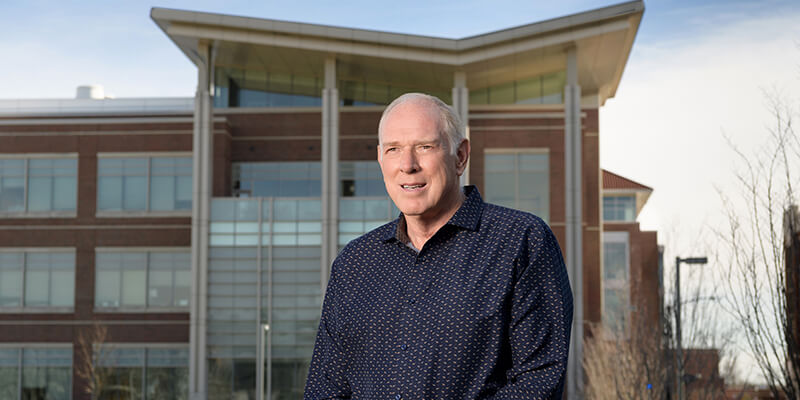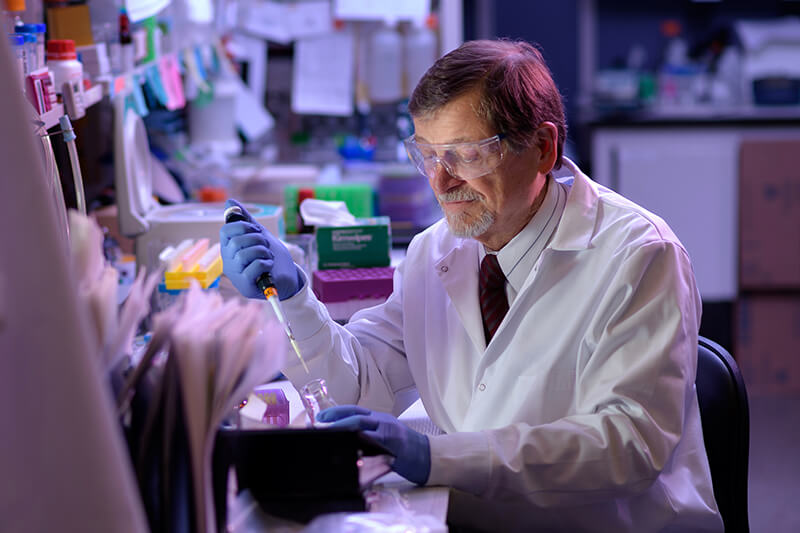December 9, 2020
New cancer immunotherapy shows great promise in early research

Philip Low, Purdue's Presidential Scholar for Drug Discovery and Ralph C. Corley Distinguished Professor of Chemistry, is leading a team that has developed a new, universal cancer immunotherapy. (Purdue University photo)
WEST LAFAYETTE, Ind. —A new approach to cancer immunotherapy has the potential to be a universal treatment for solid tumors, according to researchers at Purdue University.
Two Purdue scientists worked together to develop and test the new treatment that works not by attacking the cancer cells themselves, but by focusing on immune system cells that, ironically, feed the tumor and block other immune system cells from destroying it.
The work was led by Philip Low, Purdue's Presidential Scholar for Drug Discovery and Ralph C. Corley Distinguished Professor of Chemistry, and Timothy Ratliff, the Robert Wallace Miller Director of the Purdue Center for Cancer Research and Distinguished Professor of Comparative Pathobiology. The first details of the approach were published recently in the journal Cancer Research
 Timothy L. Ratliff, the Robert Wallace Miller Director of the Purdue University Center for Cancer Research, is part of a team of scientists who have developed the first universal cancer treatment that targets non-malignant cells in tumors. (Purdue University photo)
Timothy L. Ratliff, the Robert Wallace Miller Director of the Purdue University Center for Cancer Research, is part of a team of scientists who have developed the first universal cancer treatment that targets non-malignant cells in tumors. (Purdue University photo)
Low said the treatment is "totally unique" and has been shown to work in six different tumor types. So far, the treatment has been tested in human tumor cells in the laboratory and in human tumors in animal models.
This approach targets immune cells that the body uses to put the brakes on an immune response. In other situations, after an illness or injury, the body employs these immune suppressor cells to stop the normal healing response in order to prevent the response from careening out of control, just as you would use brakes in a car.
But in cancerous tumors, these cells have an unwelcome and disastrous effect: They hit the brakes at the wrong time and stop the body's own defenses from killing the tumor.
"We can reprogram the immune cells within the tumor to help kill the tumor instead of allowing these cells to help the tumor grow," Low said. "It's just been realized recently that as a global approach to eradicating a solid tumor, we need to also treat the healthy, non-malignant cells in the tumor."
Low explained that, depending on the type of cancer, 30%-80% of the cells in a solid tumor are not cancer cells and are used in normal functions in other tissues.
"The difference — and this is a very important difference — is that after these cells infiltrate a solid tumor mass, they are retrained by the cancer cells to facilitate tumor growth," he said. "But even though the cancer cells are very specific to the type of cancer, so that the treatment for breast cancer is different from the treatment for brain cancer, which is different from the treatment for lung cancer, etc., these nonmalignant cells within the tumor microenvironment are often very similar from one tumor to the next; so a drug that corrects the misbehavior of these nonmalignant cells could be used to treat most solid tumors."
In this technique, an anti-cancer drug that would normally be too toxic for human use is linked to folate, which is a type of vitamin B. Almost no normal cells have a receptor for the folate, so it passes on through the body, but certain cancer-associated immune cells do.
"We use the vitamin folate to target attached drugs specifically to these nonmalignant cells within a tumor mass that, unfortunately, promote tumor growth. These tumor-associated macrophages love folate," Low said. "They have an enormous appetite for it. They take it up right away, and if they don't, the compound passes in the urine within about 30 minutes. So, we 're using folate as a kind of Trojan horse to trick the tumor-promoting immune cells into eating a drug that will reprogram them into tumor-fighting immune cells."
Low said part of the drug development effort will be to ensure that the drug payload, which would be lethal to a patient by itself, is released solely within the tumor-promoting macrophage cells.
"There's a lot of molecular design and chemistry to optimize this combination," he said. "We are designing them so that if they are not taken up by the cancer-promoting cells right away, then they are out of there. If the drug isn't used right away, we want it gone."
Ratliff said this treatment may prove to be more universally effective than current cancer immunotherapies.
"There are therapeutic antibodies that are used on some types of cancer. And many people have heard of checkpoint immunotherapies, which blocks certain parts of the immune response,” Ratliff said. “When I talk to groups, I always point out that former President Jimmy Carter had metastatic brain cancer, and he went through immunotherapy, and it eliminated the cancer for him.
"But the problem is that only about 20 percent of the patients actually respond. So, we need to take a different approach to modulating the immune response."
Ratliff said the folate-targeted approach is exciting because it is the first research project that has found a way to target the cells that boost tumor growth in the tumor environment.
"These are cells that are important to the tumors, but they aren't the tumor cells themselves," he said. "By targeting these myeloid cells within the tumor, we have a universal process because these cells are present in all of the solid tumors."
As director of the Purdue University Center for Cancer Research, Ratliff co-founded Boilermaker Health Innovations, a certified nonprofit that helps fund Purdue-discovered drugs through human clinical trials. Often, compounds that make it through a Phase I trial can be sold to an established pharmaceutical manufacturer or spun off into a for-profit company.
One of the center’s most recognized success stories is Endocyte Inc., a startup originating from the work of Low, co-founder of the Boilermaker Health Innovations. Low’s research, which focuses on providing direct-targeted treatment to diseased cells through the creation of small molecules, helped the biopharmaceutical company reach its $2.2 billion value.
Low said the new immunotherapy treatment could be available to patients within a decade.
"On average, this usually takes 10 years, but we have a small team and we're aggressive. So, I think there's a reasonable chance this could make it to the public within seven years or something like that," he said. "It would probably cost a couple hundred million dollars, at the very least, to develop and test this drug.
“So it's not going to be cheap, and it's not going to be easy. But this drug has enormous potential to save many lives. So, we will do our best."
About Purdue University
Purdue University is a top public research institution developing practical solutions to today’s toughest challenges. Ranked the No. 5 Most Innovative University in the United States by U.S. News & World Report, Purdue delivers world-changing research and out-of-this-world discovery. Committed to hands-on and online, real-world learning, Purdue offers a transformative education to all. Committed to affordability and accessibility, Purdue has frozen tuition and most fees at 2012-13 levels, enabling more students than ever to graduate debt-free. See how Purdue never stops in the persistent pursuit of the next giant leap at https://purdue.edu/.
Writer, Media contact: Steve Tally, steve@purdue.edu, @sciencewriter
Sources: Low, plow@purdue.edu
Ratliff, tlratliff@purdue.edu
Journalists visiting campus: Journalists should follow Protect Purdue protocols and the following guidelines:
- Campus is open, but the number of people in spaces may be limited. We will be as accommodating as possible, but you may be asked to step out or report from another location.
- To enable access, particularly to campus buildings, we recommend you contact the Purdue News Service media contact listed on the release to let them know the nature of the visit and where you will be visiting. A News Service representative can facilitate safe access and may escort you on campus.
- Correctly wear face masks inside any campus building, and correctly wear face masks outdoors when social distancing of at least six feet is not possible.
ABSTRACT
Folate Receptor Beta Designates Immunosuppressive Tumor-Associated Myeloid Cells that Can Be Reprogrammed with Folate-Targeted Drugs.
Gregory M. Cresswell, Bingbing Wang, Erin M. Kischuk, Meaghan M. Broman, Rami A. Alfar, Renee E. Vickman, Dimiter S. Dimitrov, Sumith A. Kularatne, Chandru P. Sundaram, Sunil Singhal, Evgeniy B. Eruslanov, Scott A. Crist, Bennett D. Elzey, Timothy L. Ratliff and Philip S. Low
DOI: 10.1158/0008-5472.CAN-20-1414
Although immunotherapies of tumors have demonstrated promise for altering the progression of malignancies, immunotherapies have been limited by an immunosuppressive tumor microenvironment (TME) that prevents infiltrating immune cells from performing their anti-cancer functions. Prominent among immunosuppressive cells are myeloid-derived suppressor cells (MDSC) and tumor-associated macrophages (TAM) that inhibit T cells via release of immunosuppressive cytokines and engagement of checkpoint receptors. Here we explore the properties of MDSC and TAM from freshly isolated mouse and human tumors and find that an immunosuppressive subset of these cells can be distinguished from the non-immunosuppressive population by its upregulation of folate receptor beta (FRβ) within the TME and its restriction to the TME. This FRβ+ subpopulation could be selectively targeted with folate-linked drugs. Delivery of a folate-targeted TLR7 agonist to these cells i) reduced their immunosuppressive function, ii) increased CD8+ T cell infiltration, iii) enhanced M1/M2 macrophage ratios, iv) inhibited tumor growth, v) blocked tumor metastasis, and vi) improved overall survival without demonstrable toxicity. These data reveal a broadly applicable strategy across tumor types for reprogramming MDSC and TAM into anti-tumorigenic immune cells using a drug that would otherwise be too toxic to administer systemically. The data also establish FRβ as the first marker that distinguishes immunosuppressive from non-immunosuppressive subsets of MDSC and TAM. Because all solid tumors accumulate MDSC and TAM, a general strategy to both identify and reprogram these cells should be broadly applied in the characterization and treatment of multiple tumors.
Note to journalists: Photos of researchers Low and Ratliff are available via a Google Drive folder. Journalists visiting campus should follow visitor health guidelines.

